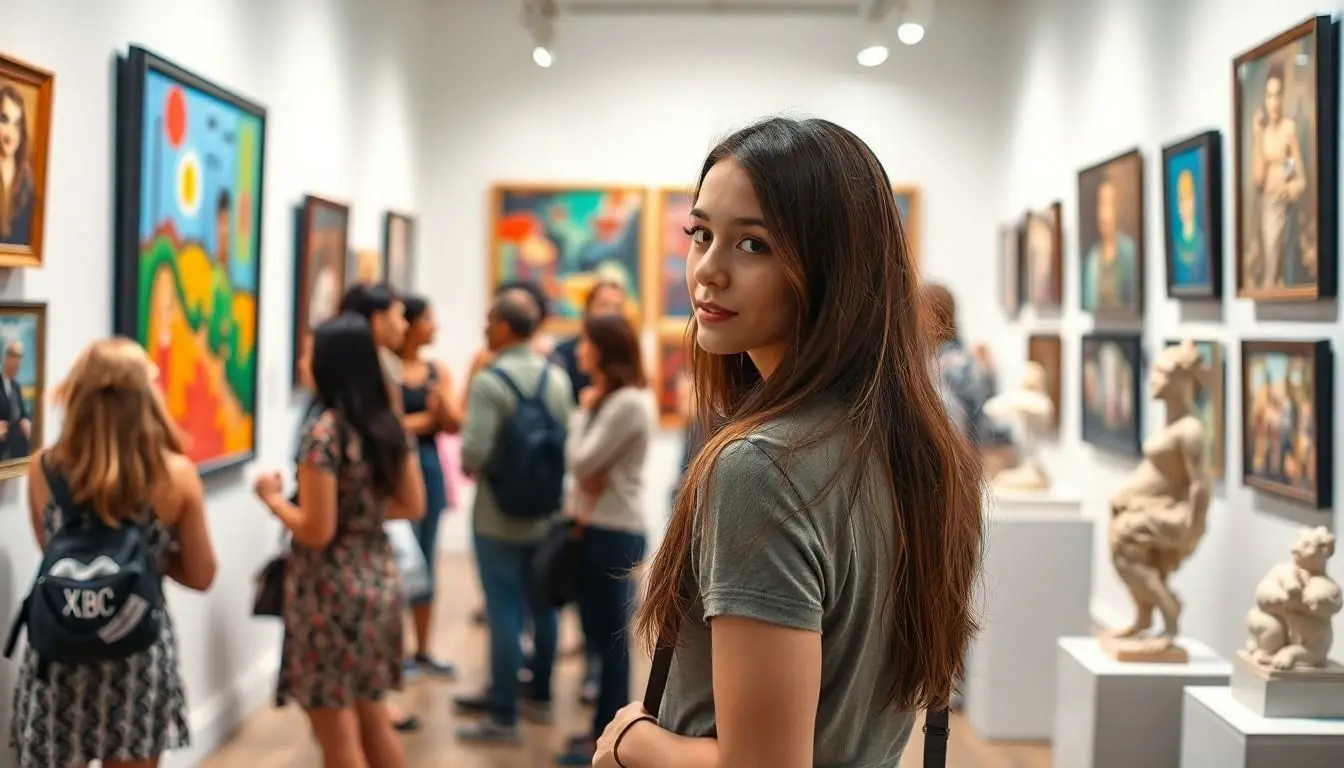Art galleries often seem like magical spaces where creativity reigns supreme, but behind the scenes, they’re running a business like any other. How do these vibrant hubs of culture manage to keep the lights on while showcasing masterpieces? Spoiler alert: it’s not just about selling overpriced coffee and hosting wine-soaked opening nights.
From commission fees on sold artwork to membership programs that make patrons feel like VIPs, galleries have a few tricks up their sleeves. They also tap into sponsorships and grants, proving that art isn’t just a feast for the eyes; it can be a buffet for the wallet too. So let’s dive into the colorful world of art galleries and uncover the financial formulas that keep them thriving in a world that often overlooks their value.
Table of Contents
ToggleUnderstanding Art Galleries
Art galleries operate as commercial entities, balancing the promotion of artists with the need for financial sustainability. They generate income primarily through commission fees on artwork sales. Commissions typically range from 30% to 50%, depending on gallery policies and the artist’s reputation.
Membership programs offer another avenue for revenue, providing patrons exclusive access to events, previews, and educational resources. These memberships foster community engagement while generating predictable income.
Sponsorships and partnerships with corporations play a crucial role in funding gallery activities. Businesses often seek visibility by associating themselves with cultural initiatives. Grants from arts organizations and government agencies can also provide significant support. These funds help galleries cover operational costs and host special exhibitions.
Additionally, galleries may sell merchandise, such as prints, books, or event packages, contributing to their overall revenue. Some establishments host workshops or classes, attracting participants and diversifying their income streams.
Fundraising events like auctions serve dual purposes: raising money and promoting artists. Successful events often attract high-profile patrons, enhancing the gallery’s visibility in the art community.
Art galleries operate within a unique ecosystem, where financial viability and artistic integrity must coexist. They navigate market trends, managing curator selections and programming strategies to align with audience preferences while maintaining their mission to support artists.
Revenue Streams for Art Galleries

Art galleries generate income through diverse avenues. Understanding these revenue streams provides insight into their financial sustainability.
Artwork Sales
Artwork sales serve as a primary revenue source for galleries. Artists display their work to attract buyers, and galleries showcase a variety of art styles, which caters to different customer preferences. Selling paintings, sculptures, and other artworks enhances revenue. Successful galleries often sell works across multiple price ranges, appealing to novice collectors and established investors alike. Promotions and exhibitions frequently stimulate interest, leading to increased sales and higher visibility for both the gallery and the artist.
Commission from Artists
Commission from artists forms a significant portion of a gallery’s income. Galleries typically take a percentage, often between 30% and 50%, of the sale price from sold pieces. This arrangement motivates galleries to market their artists effectively, ensuring that artwork reaches potential buyers. Striking partnerships with emerging and established artists helps galleries maintain a competitive edge. As a result, the commission model fosters a mutually beneficial relationship that encourages continuous collaboration and artistic growth.
Ticket Sales
Ticket sales represent an additional source of revenue for galleries. Admission fees for special exhibitions, events, and private viewings generate substantial income. Events such as opening receptions and artist talks often attract attendees willing to pay for unique experiences. Offering workshops and educational programs also enhances ticket sales while fostering community engagement. Strong attendance at these events can significantly impact a gallery’s financial health, while providing valuable opportunities for patrons to connect with art and artists.
Events and Programs
Art galleries leverage events and programs to enhance their revenue while promoting community involvement and artistic engagement. These activities not only attract visitors but also create opportunities for financial gain.
Art Fairs and Exhibitions
Participation in art fairs and exhibitions plays a vital role in revenue generation. Galleries often showcase artists’ works at these events, connecting with collectors and art enthusiasts. Selling pieces at art fairs can yield substantial profit, with galleries sometimes earning commission rates between 30% and 50%. Engaging directly with potential buyers increases visibility and strengthens relationships with the art market. Moreover, the networking opportunities presented at these events can lead to future sales and partnerships, bolstering financial sustainability.
Workshops and Classes
Workshops and classes offer another stream of income for galleries. These hands-on programs attract art lovers who seek to enhance their skills, creating an engaging learning environment. Pricing for workshops often varies, depending on the duration and material used, with fees typically ranging from $50 to $200 per participant. Galleries benefit from these courses by diversifying their offerings and attracting a wider audience. Enthusiasts not only learn new techniques but also develop deeper connections with the gallery and its mission, fostering a sense of community.
Sponsorships and Donations
Sponsorships and donations offer significant financial support for art galleries. Numerous corporations seek to enhance their public image by aligning with cultural institutions, providing galleries with much-needed funds. These partnerships can take various forms, such as funding specific exhibitions or supporting outreach programs.
Donations from individuals passionate about the arts also contribute to gallery sustainability. Wealthy patrons often provide substantial financial contributions, allowing galleries to expand their programming and enhance resources. In return, galleries frequently acknowledge these donations through various means, including naming opportunities and special events.
Grants represent another essential avenue for funding. Many art galleries apply for grants offered by governmental and private organizations focused on promoting the arts. Successful applications can lead to funding for educational initiatives, exhibitions, or community engagement projects.
Collaboration with local businesses further strengthens gallery funding. Strategic partnerships often lead to co-hosted events, benefiting both the gallery and the sponsors through increased visibility. These collaborations enhance the gallery’s financial viability while fostering community connections.
Ultimately, maximizing sponsorships and donations plays a crucial role in mitigating financial challenges faced by art galleries. By building strong relationships with corporations, individuals, and grant-giving organizations, galleries secure vital resources that support their operations and artistic missions.
Digital Presence and Sales
Art galleries increasingly depend on their digital presence to generate revenue and reach wider audiences. Online sales platforms and social media strategies play crucial roles in achieving these goals.
Online Gallery Platforms
Online gallery platforms offer galleries a chance to showcase their artists and sell artwork to global buyers. Many galleries now join platforms like Artsy or Saatchi Art, where they can list pieces and gain exposure. Artwork sold through these channels typically incurs a commission fee, aligned with what galleries charge for in-person sales. Utilizing virtual exhibitions also attracts potential buyers unable to visit physically. Some platforms provide analytics tools, allowing galleries to assess buyer interest and preferences, guiding marketing strategies.
Social Media Marketing
Social media marketing serves as a powerful tool for galleries to engage with audiences and promote their collections. Platforms like Instagram and Facebook facilitate visual storytelling, capturing the essence of artworks. Using targeted ads expands reach, attracting potential buyers and art enthusiasts. Artwork previews, artist interviews, and behind-the-scenes content create buzz around new exhibitions. Interactive posts, including polls and Q&A sessions, foster community engagement, strengthening the gallery’s relationship with its audience. Effective social media strategies enhance visibility and drive traffic to online sales, contributing significantly to galleries’ financial stability.
Art galleries employ diverse strategies to ensure financial sustainability while promoting artistic expression. By leveraging commission fees from artwork sales and creating engaging membership programs, they cultivate a loyal patron base. Sponsorships and grants provide essential funding, allowing galleries to expand their reach and enhance community involvement.
The growing emphasis on digital platforms enables galleries to connect with a broader audience and increase sales opportunities. As they adapt to market trends and embrace innovative revenue streams, art galleries continue to play a vital role in both the art world and local communities. Their ability to balance financial health with artistic integrity ultimately secures their place as essential cultural institutions.





